Robinson Moth Traps are the preferred choice amongst many serious entomologists because they offer the highest attraction and retention rates. There are various models available and NHBS offers a comprehensive range – we’ve put together this guide to Robinson Moth Traps to help you choose the right model. We have also included our top tips to improve the efficiency of your Robinson Trap in use.
Similarities
NHBS sells a variety of Robinson moth trap types, varying in both price and specifications. However, before we get into the differences, let’s consider their similarities. All our Robinson traps are;
- Supplied fully wired so you can start using them straight away
- Fitted with an IP56 waterproof control box housing the appropriate chokes and capacitors
- Supplied with a bulb (either mercury vapour (MV) or actinic depending on the trap chosen)
- Supplied with 240V electrics (including 3-pin plug) or 12V battery powered electrics
- Fitted with a rain guard for the mercury vapour bulb (MV Robinsons only)
- Fitted with flight interception baffles
- Complete with drainage hole in centre of base (holes are either too small to allow moths to escape or fitted with gauze)
Differences
Before we analyse each trap individually, remember that any one of these traps will attract moths in large numbers. Robinson moth traps fitted with mercury vapour bulbs are the most successful traps for attracting and retaining moths. On a very good night you can expect 500 – 1000 moths. So, what are the types of Robinson we offer?
NHBS Robinson moth trap: we’ve specially designed this trap to make it as cheap as possible for those on a budget or those new to mothing. Robinson moth traps aren’t cheap and we’ve done all we can to reduce the price. That said, the electrics are still the same as the other Robinson moth traps and it will still attract large numbers of moths.
![]() Standard Robinson moth trap: this long-term favourite is our most popular design and combines a superb design with affordability. It is larger and more robust than the NHBS Robinson but lacks one or two features of the Heavy Duty Robinson. This trap is an excellent choice for both professionals and enthusiasts.
Standard Robinson moth trap: this long-term favourite is our most popular design and combines a superb design with affordability. It is larger and more robust than the NHBS Robinson but lacks one or two features of the Heavy Duty Robinson. This trap is an excellent choice for both professionals and enthusiasts.
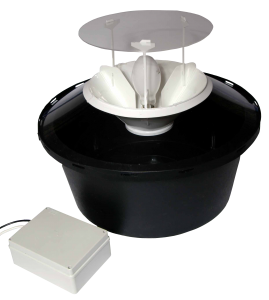 Heavy Duty Robinson moth trap: this trap is robust and durable, making it ideal for prolonged use. It combines many great features of a Robinson trap to provide a durable design.
Heavy Duty Robinson moth trap: this trap is robust and durable, making it ideal for prolonged use. It combines many great features of a Robinson trap to provide a durable design.
60W Actinic Robinson moth trap: this Robinson moth trap has actinic electrics rather than mercury vapour electrics. It also has the same components and dimensions as the Standard Robinson moth trap.
Midi Robinson moth trap: the Midi Robinson moth trap is the latest edition to the NHBS range of Robinson moth traps. It has the smallest dimensions of any Robinson moth trap and is available in either a Mercury Vapour or Actinic version.
Actinic vs Mercury Vapour
When choosing between mercury vapour and actinic electrics, there are several general rules to consider. Mercury vapour bulbs will attract the largest amount of moths. However, they are also quite bright. If using the trap in a small back garden, you may want to opt for actinic electrics. These produce less light and so are less likely to annoy the neighbours. Mercury vapour bulbs run hot and so need to be protected from the rain to avoid shattering. All our mercury vapour Robinson traps come with a rain guard as standard. Actinic bulbs do not run hot and so do not need protecting from the rain.
If you decide on actinic electrics, then you can choose between the 60W Actinic Robinson and the Actinic Midi Robinson. The 60W Actinic Robinson is essentially the same trap as our Standard MV Robinson moth trap, but has 2 x 30W actinic bulbs that run off a mains supply or generator. The Actinic Midi Robinson is smaller than the 60W Actinic Robinson. The Midi has 1 x 15W actinic bulb that is designed to run off a 12V battery. Thus it is much more portable as it does not have to be plugged into mains electrics, but won’t attract as many moths as it’s not as powerful.
If It’s Mercury Vapour You Want…!
If you decide on a Mercury Vapour Robinson moth trap, then NHBS has a range of options to cater for various situations and budgets.
Small is Beautiful
For those wanting the cheapest mercury vapour Robinson trap available, the MV Midi Robinson is the trap for you. But just because it is the cheapest, it doesn’t mean the quality of the trap has been compromised. Essentially it is the same trap as our best seller, the Standard Robinson moth trap, but with a few alterations to reduce the price. Firstly, it’s smaller with a base diameter of 45cm compared to the 60cm base of the Standard Robinson trap. This makes it more portable but means there’s less space for moths – a potential consideration if trapping on the busiest of nights. The Midi Robinson has an 80W MV bulb, as opposed to the other MV Robinson traps that all run 125W MV bulbs. This means the Midi is less powerful and so may attract fewer moths. However, the build quality and components used are identical to those used on the Standard Robinson moth trap, so the Midi will still provide a durable and effective method of trapping moths.
125W MV Robinson Moth Traps – One of Three to Choose!
If you’ve decided against an actinic Robinson, and consider the Midi Robinson to be too small, or just simply want the most powerful Robinson trap available, then it’s a 125W MV Robinson you’ll be wanting! There are three 125W MV Robinson traps to choose between; NHBS MV Robinson, Standard MV Robinson, and the Heavy Duty Robinson.
When choosing between these three types of trap, you may want to consider the following;
Trap Electrics
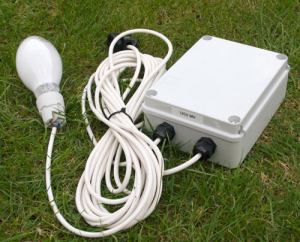 All three trap designs fundamentally have the same 240V electrics with all the necessary chokes, capacitors, etc included. As they all run a 125W mercury vapour bulb, there won’t be any noticeable differences in light intensity or attraction rates of moths. Where they do differ is in the cable lengths. The NHBS Robinson has a short input cable (that runs from the mains plug to the waterproof control box) of approximately 1.5 metres. The Standard Robinson has approximately 5 metres of input cable, whilst the Heavy Duty Robinson has 15 metres of input cable. So, you’ll probably need an extension cable for use with the NHBS Robinson. The output cable (that runs from the control box to the bulb) is short for all three designs (1 – 2 metres).
All three trap designs fundamentally have the same 240V electrics with all the necessary chokes, capacitors, etc included. As they all run a 125W mercury vapour bulb, there won’t be any noticeable differences in light intensity or attraction rates of moths. Where they do differ is in the cable lengths. The NHBS Robinson has a short input cable (that runs from the mains plug to the waterproof control box) of approximately 1.5 metres. The Standard Robinson has approximately 5 metres of input cable, whilst the Heavy Duty Robinson has 15 metres of input cable. So, you’ll probably need an extension cable for use with the NHBS Robinson. The output cable (that runs from the control box to the bulb) is short for all three designs (1 – 2 metres).
Base
The bases of all three traps are made of black plastic and have drainage holes. The NHBS Robinson has a smaller diameter base (approx. 50 cm) compared to the other two designs (approx. 60 cm). Therefore, the NHBS Robinson has a smaller area for moth retention. The base of the Heavy Duty Robinson is particularly durable and has a drainage hole fitted with gauze. The Standard Robinson also has a drainage hole with gauze covering, whilst the NHBS Robinson has small holes drilled into the base to provide drainage. All of the bases can be easily repaired in the event of minor cracks and breakages.
Collar
The collar of the NHBS Robinson is made of 3 mm black plastic and cannot be removed from the base. Therefore, you won’t be able to see into the trap whilst it’s on, but the thick plastic will last for many years. The collar of the Standard Robinson is made of 3 mm thick clear plastic and can be removed from the base. You’ll be able to see inside whilst the trap is on. The collar of the Heavy Duty Robinson is also made of 3 mm thick clear plastic and is removable from the base. As you can remove the collars on the Standard and Heavy Duty Robinson, you can stack the bases into each other (for bases of the same model) for storage. The collar of the NHBS Robinson is not removable so traps cannot be stacked inside each other. The collars on all three traps are made of UV stable plastic and will be more resistant to brittleness; a common complaint for less robust collar designs.
Cone and Rain Guard
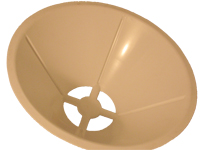 All three trap designs have a white cone and rain guard. The NHBS and Heavy Duty Robinson traps have similar designs of cone with three flight interception baffles and a sturdy rain guard design which screws tight for rigidity. The Standard Robinson has four flight interception baffles that are slightly more prominent in profile. The rain guard, whilst having four supports, does not screw down for security. Therefore, in high winds it may be prone to being blown over; although if high winds are predicted it’s unlikely you’ll be using the trap anyway!
All three trap designs have a white cone and rain guard. The NHBS and Heavy Duty Robinson traps have similar designs of cone with three flight interception baffles and a sturdy rain guard design which screws tight for rigidity. The Standard Robinson has four flight interception baffles that are slightly more prominent in profile. The rain guard, whilst having four supports, does not screw down for security. Therefore, in high winds it may be prone to being blown over; although if high winds are predicted it’s unlikely you’ll be using the trap anyway!
If you’ve got any other questions regarding the three trap types then please contact customer services.
Hints and Tips
Regardless of the Robinson design, there are several ways to improve the efficiency of your Robinson moth trap.
- The majority of adult moths are nectar feeders, so site your trap in areas full of native plants. Make your garden into a wildlife haven and you’ll hopefully see a big increase in moth numbers. You may have to accept increased damage to your plants as you should avoid the use of pesticides.
- Improve the attractiveness of your garden by using plants that release their strongest scent during the evening, such as nicotinia and night-scented stock or honeysuckle.
- Cold, clear nights (especially following a period of milder weather) will reduce the numbers of moths available for trapping. Cloudy, warm nights are best, especially as it tends to be darker on cloudy nights and so less light pollution will be competing with the trap light.
- Avoid trapping on bright nights with a full moon or near other sources of light, e.g. street lamps.
- Avoid windy or wet nights as moths are less inclined to fly and to avoid damage to the trap.
- If air masses are moving up from the South, southern coastal areas of the UK may see increased numbers of migrants being blown over from the continent.
- Peak mothing months are July and August. However, moths may be seen in substantial numbers at other times of the year, especially in rural areas.
Remember to think about the moths too! Avoid trapping on consecutive nights in small gardens as you may be trapping the same moths, thus preventing them from feeding and mating. You can reduce the chance of re-trapping the same moths by releasing moths at least 50 metres from the trap site. Ideally release the moths into dense vegetation so that they have a daytime refuge from predators. If leaving the trap overnight, try and check it early in the morning. Occasionally you may find wasps and hornets in the trap. Wasps may kill moths and hornets will eat them, but both wasps and hornets are docile in the morning so can be removed with minimal effort. Avoid trapping near known hornets nests. If you can’t inspect your trap until later in the day, ensure it is in a shady area and place a damp cloth or sponge in the bottom of the trap to reduce the chances of dehydration.
Trap Components
We also provide trap electrics, bulbs and individual trap component separately. Not all components are listed on the website, so if you can’t find what you’re looking for then get in touch with customer services. Similarly, if you have any other questions then please get in touch.

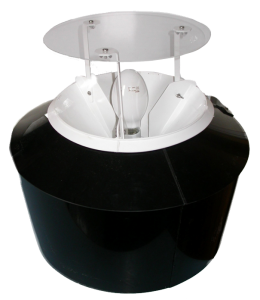

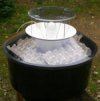
Do you produce a solar powered version of the actinic bulb for use in orchards?
Thanks, I’m replacing a home made skinner trap this year and I’m wondering what to get in its place. Your article has
helped me a great deal.
Hi Pat,
I am glad to hear that our article has helped you choose a new trap. If you have any questions or queries on specific traps or would like any other advice, feel free to ask us on here or drop us an email at customer.services@nhbs.com.
Many thanks,
Antonia Peacock
Wildlife Equipment Specialist – NHBS